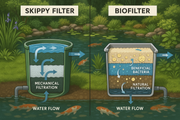
Choosing the right filter can turn a cloudy, algae-ridden pond into the crystal-clear centerpiece of your garden. If you’ve already invested time (and money) in fish, plants, and hard-scape, the last thing you want is water that looks and smells like swamp soup. Two of the most talked-about solutions are the biofilter (often sold as a complete plug-and-play unit) and the Skippy pond filter (a popular DIY favorite). Which of these delivers cleaner, healthier water for the long haul—and which one makes the most sense for your budget and skill level? Let’s break it down.
Why Biological Filtration Matters
Mechanical mats and skimmers catch leaves, fish waste, and excess food, but that’s only half the battle. Beneath the surface, toxic ammonia—produced every time your koi breathe or nibble—must be converted by beneficial bacteria into nitrite and finally nitrate. Neglect this biochemical “detox” and you’ll see stressed fish, rapid algae growth, and foul odors.
A dedicated pond biofilter provides miles of surface area for these bacteria to live on. The larger and more oxygen-rich the media, the more waste your system can safely process—crucial if you keep koi, which produce more waste per pound than most aquarium fish.
What Is a Biofilter?

A modern biofilter for koi pond use is usually a factory-sealed canister or box packed with lightweight media—bio-balls, ceramic rings, high-porosity foam, or a mix of all three. Water is pumped through the chamber, bacteria colonize the media, and the toxins are digested in a continuous, closed loop.
Professional units like the Poposoap Solar Pond Filter series add two big twists:
- Built-in solar panels mean the pump and UV clarifier run on daylight, eliminating utility bills and allowing off-grid placement far from electrical outlets.
- Multi-stage cartridges combine mechanical pads (to trap solids), activated carbon (to polish water), and biological media (to house bacteria)—all in one compact shell.
Because biofilters arrive pre-assembled, the learning curve is minimal: connect the intake hose, secure the outflow, set the solar panel in full sun, and you’re done.
What Is a Skippy Filter?

Born from the pond-keeper community, the Skippy filter is the ultimate do-it-yourself biofilter. It relies on an up-flow design:
- A sturdy stock tank or plastic barrel sits beside the pond.
- Water is pumped into the bottom.
- It percolates upward through layers of coarse filter pads, nylon pot-scrubbers, or landscaping mesh.
- Cleaned water overflows back into the pond—often forming a small waterfall.
Because the media is coarse and oxygen-rich, sludge tends to settle on the floor of the barrel while beneficial bacteria thrive along every surface. Many owners report running a Skippy filter an entire season with zero rinsing.
Why hobbyists love it
- Low cost per gallon filtered—great for very large ponds.
- Easy to source materials from a hardware store.
- Almost maintenance-free once bacteria mature.
Why it’s not for everyone
- It’s bulky and can be an eyesore without landscaping.
- Leak-proof plumbing and lid-sealing require basic DIY skills.
- Performance depends heavily on sizing the barrel, pump flow, and media correctly.
Skippy Filter vs. Biofilter: Head-to-Head

Ease of installation – A packaged biofilter such as the Poposoap Solar Pond Filter drops into place in minutes; every hose barb and O-ring is factory-matched. The Skippy pond filter demands an afternoon of drilling, fitting bulkheads, and cutting media to size.
Footprint & aesthetics – Biofilters are compact, often camouflaged behind a rock or shrub. A 50-gallon DIY barrel sticks out unless buried or screened with plants.
Energy consumption – Poposoap’s solar pumps run on the sun, cutting electric costs to zero. A Skippy filter still needs a pump—and unless you add your own solar gear, that pump draws household electricity 24/7.
Maintenance – Biofilters use removable pads that slide out for a quick rinse. The Skippy philosophy is “no cleaning”—great until excessive sludge lowers flow or causes odor, at which point you’ll end up draining and hosing out a heavy barrel.
Scalability – Factory biofilters top-out around medium-size hobby ponds (500–1,500 gallons). Want a 5,000-gallon lily pond? The barrel-based Skippy filter scales cheaply by using livestock tanks.
Which One Should You Choose?
Pick a biofilter if you want turnkey simplicity, minimal visual impact, and renewable-energy operation. A Poposoap Solar Pond Filter is perfect for homeowners who’d rather watch fish than tinker with plumbing.
Pick a Skippy pond filter if you enjoy hands-on projects, need to handle high fish loads, and don’t mind a barrel hidden behind reeds or a deck. The DIY route shines when every dollar must stretch to maximum water volume.
Remember, both paths achieve the same goal—housing enough bacteria to keep ammonia and nitrite at zero. Your ideal solution depends on space, budget, and whether you’d rather plug-and-play or build-and-pray.
Pro Tip: Combine with a Mechanical Pre-Filter
(Use a Poposoap Filter Box or pre-filter sponge)
Even the best biological chamber won’t perform if solid gunk clogs its pores. Slip a Poposoap Filter Box with Filter Media (a rugged, mesh-lined basket) over your pump or add a simple pre-filter sponge. These upgrades screen out leaves, string algae, and uneaten food before they reach the heart of your biofilter—extending service intervals and boosting water clarity.
Conclusion: Both Are Great—It’s About Your Pond’s Needs
At the end of the day, biofilters and Skippy filters are two sides of the same coin. One delivers polished, professional convenience; the other offers budget-friendly capacity with a dash of DIY pride. Whichever you choose, pair it with good mechanical pre-filtration, ample aeration, and routine water testing. Your reward? A pond so clear you’ll swear your koi are floating in mid-air.







